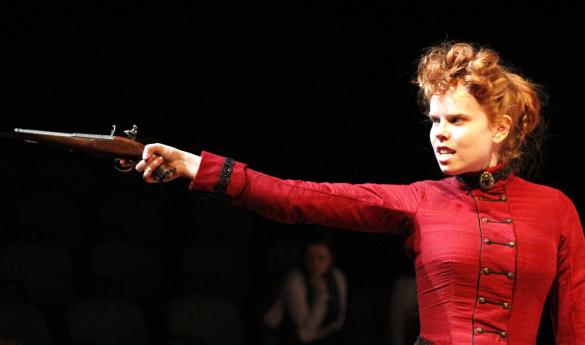Hedda Gabler uncovers skeleton of human nature
At George Mason University, an institution founded on the principles of its namesake that all men are created equal, the Mason Players explored the shackles of the eighteenth century genteel society in Henrik Ibsen’s “Hedda Gabler.”
Hedda Gabler, played by junior Theater major Ruthie Rado, acts as a phoenix in this constrictive story as men and women alike scramble to please and charm her. Hedda, both devil and pseudo upper class socialite, is pulled by the same strings that yank the other characters by their elaborate hats and lapels, but—whether by a combination of her personality traits or her ingrained sensibilities—she reacts to these structures with a sharp, impatient tongue.
Halah Zenhom, senior Theater major and director of this play, saw the story of “Hedda Gabler” as a slice of humanity. As she wrote in her director’s note, “We continue to return to this play, these characters, because as people we can participate in the struggle to make the right choice.” In this play, Zenhom wrote, the choice is between evolving into something beautiful and losing control of one’s “human wholeness.”
This theatrical battle for human nature was housed in a lovely, stationary set designed by Nick Arancibia, a senior Theater major. The space was clearly defined and believably lived in by the characters roving its rich, wooden floorboards.
The color scheme for the walls vividly contrasted the characters and their costumes, designed by junior Theater major Roman Voytko Barrosse. Many of the costume pieces were gorgeous, although some—specifically Hedda’s final piece—took away the aesthetic perfection that ran through most of the show.
Sound and lighting design contrasted the play both in intention and in style. While the costumes, set and characters made occasionally bold but always deliberate decisions, the sound and lighting design, especially their execution, were late and jarring. However, the special effects using lighting—specifically the stand-alone fire hutch that glowed as if with a real flame—were surprising and added to the human quality of the play
The brightest light of the play was the twisted yet alluring relationship between Rado’s Hedda Gabler and Judge Brack, played by senior Theater major Alec Henneberger. While the other characters timidly or worriedly milled around to go about their business, the relationship between the judge and Hedda captured attention immediately. They were equally wicked and witty as they were superior to their surroundings, making them magnetic to the audience.
Not to say, however, that other performances paled in comparison to this remarkable relationship. The nature of the play throws the other characters into static roles that they battle against their own human natures force them to feel envy and lust that they wish to ignore. It is when the judge or Hedda touch the human natures of these other characters that disaster often strikesultimately, death.
Although intended to be about “free and courageous action,” this play would be better described as a piece that exposes the infrastructure of western society. It heats the flame of human nature into life and contains it in corsets, forcing it to curtsy and indulge social niceties until humanity is smothered by smoke.

